Fire extinguishers play a critical role in fire safety, providing a first line of defense against small fires. Available in types like water, foam, CO2, and dry powder, they are essential for controlling various fire classes, ensuring safety in homes, offices, and industrial settings; Proper selection and use are vital to effectively manage emergencies.
1.1 Importance of Fire Extinguishers in Safety
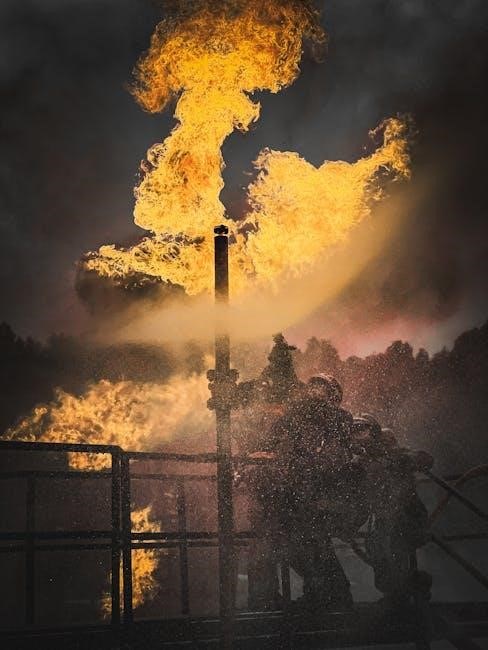
Fire extinguishers are essential tools for controlling and extinguishing fires in their early stages, preventing them from spreading and causing greater damage. They play a vital role in protecting lives, property, and assets by providing a quick response mechanism in emergency situations. In workplaces, homes, and public spaces, fire extinguishers act as a first line of defense, allowing individuals to manage small fires before they escalate. Properly selected and maintained extinguishers ensure safety by addressing specific fire hazards, such as combustible materials, electrical equipment, or flammable liquids. Their presence and correct use can significantly reduce risks, making them indispensable in any fire safety plan. Regular inspections and training on their use further enhance their effectiveness.
1.2 Brief Overview of Fire Extinguisher Types
Fire extinguishers are categorized into several types, each designed to combat specific fire hazards. Water extinguishers are ideal for Class A fires involving combustible solids like wood and paper. Foam extinguishers are effective against Class B fires, such as those involving flammable liquids. CO2 extinguishers are suitable for Class C fires, particularly electrical equipment, as they leave no residue. Dry powder extinguishers are versatile and can tackle Class A, B, and C fires, making them a popular choice. Wet chemical extinguishers are specialized for Class K fires, such as cooking oils and fats. Additionally, Lithium-Ion Battery Fire Extinguishers are a newer type designed to address fires from lithium-based batteries. Each type has distinct characteristics, ensuring they are matched to the appropriate fire class for maximum effectiveness.
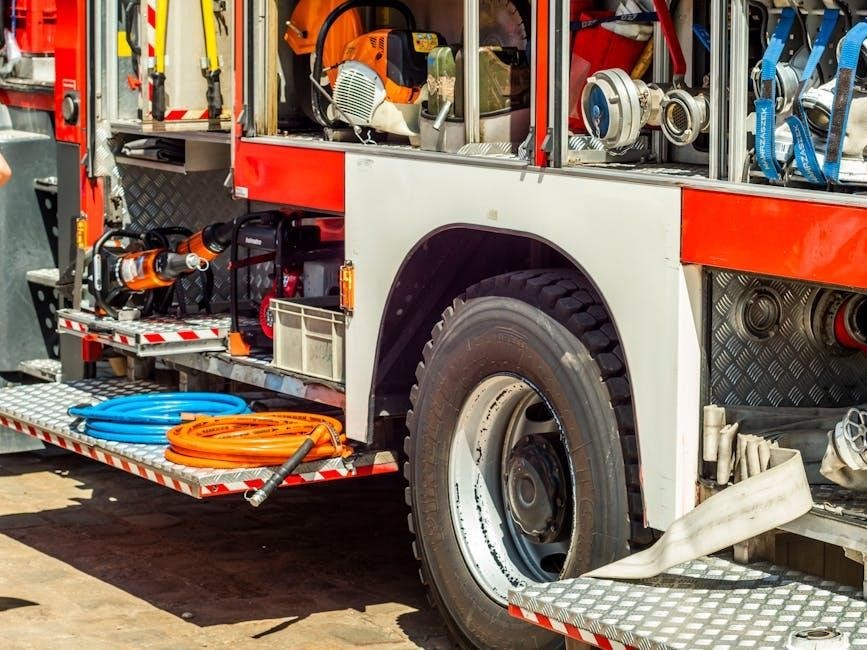
Types of Fire Extinguishers
Fire extinguishers are categorized into various types, including water, foam, CO2, dry powder, wet chemical, and lithium-ion battery extinguishers, each designed for specific fire scenarios.
2.1 Water Fire Extinguishers
Water fire extinguishers are one of the most commonly used types, primarily effective for Class A fires involving combustible solids like wood, paper, and textiles. They work by cooling the fire, reducing its temperature below the ignition point. These extinguishers are often filled with water or a water-based solution and are typically red in color for easy identification. Water extinguishers are suitable for use in homes, offices, and industrial settings where Class A fires are a primary risk. However, they are not recommended for electrical fires or flammable liquids, as water can conduct electricity or spread the fire. Regular maintenance is essential to ensure their effectiveness in emergencies.
2.2 Foam Fire Extinguishers
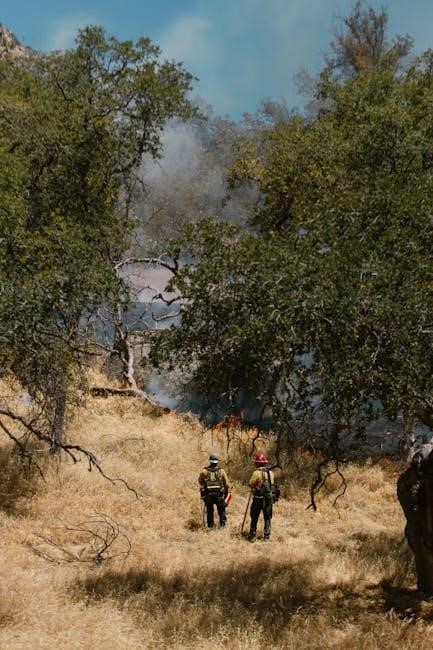
Foam fire extinguishers are highly effective for controlling Class B fires, which involve flammable liquids such as gasoline, oil, and paint. They work by creating a thick, suffocating layer of foam that prevents oxygen from reaching the fuel, thereby extinguishing the fire. Some foam extinguishers are also suitable for Class A fires, such as those involving wood or paper, making them versatile for various scenarios. However, they are not recommended for Class C fires involving electrical equipment, as the foam can conduct electricity and pose a safety risk. Proper training is essential for their safe and effective use in emergencies. Always choose the right type of foam extinguisher based on the specific fire hazard present.
2.3 CO2 Fire Extinguishers
CO2 fire extinguishers are highly effective for Class B (flammable liquids) and Class C (electrical) fires. They work by displacing oxygen, smothering the fire without leaving residue. Ideal for sensitive areas like server rooms or laboratories, CO2 extinguishers are non-conductive and safe for electrical equipment. However, they are not suitable for Class A fires involving combustible solids. The discharge is extremely cold, requiring careful handling. CO2 extinguishers are popular in industrial and commercial settings due to their versatility and clean operation. Proper training is essential to use them effectively in emergencies. Regular maintenance ensures they remain functional and ready for deployment.
2.4 Dry Powder Fire Extinguishers
Dry powder fire extinguishers are versatile and widely used for combating various types of fires. They are effective against Class A (combustible solids), Class B (flammable liquids), and Class C (electrical equipment) fires. The dry powder works by smothering the flames and starving the fire of oxygen. These extinguishers are particularly useful in environments with mixed fire risks, such as offices, industrial spaces, and vehicles. However, they are not suitable for Class K fires (cooking oils and fats) or areas requiring clean agent solutions. The dry powder can leave a residue, so cleanup is necessary after use. Proper training is essential for effective deployment in emergencies.
2.5 Wet Chemical Fire Extinguishers
Wet chemical fire extinguishers are specifically designed to combat Class K fires, which involve cooking oils and fats. They are highly effective in commercial kitchens, where such fires are common. These extinguishers work by releasing a wet chemical agent that cools the fuel and creates a barrier, preventing oxygen from reaching the fire. Unlike dry chemical extinguishers, wet chemical models are designed to prevent re-ignition by forming a protective layer on the surface of the burning material. They are ideal for deep-fat fryers and grills, making them a critical component of fire safety in food service environments. Regular maintenance is essential to ensure their reliability in emergencies.
2.6 Lithium-Ion Battery Fire Extinguishers
Lithium-ion battery fire extinguishers are a relatively new and specialized type, designed to tackle fires involving lithium-ion batteries. These fires are highly hazardous due to the risk of thermal runaway and explosive chemical reactions. Specifically engineered to suppress such fires, these extinguishers use advanced agents that cool the batteries and prevent further ignition. Unlike traditional extinguishers, they are non-conductive and safe for use on electrical fires. Ideal for Class B (flammable liquids) and Class C (electrical) fires, they are essential in environments with high battery usage, such as homes, offices, and industrial facilities. Their unique formulation ensures minimal residue and collateral damage, making them a critical tool in modern fire safety.
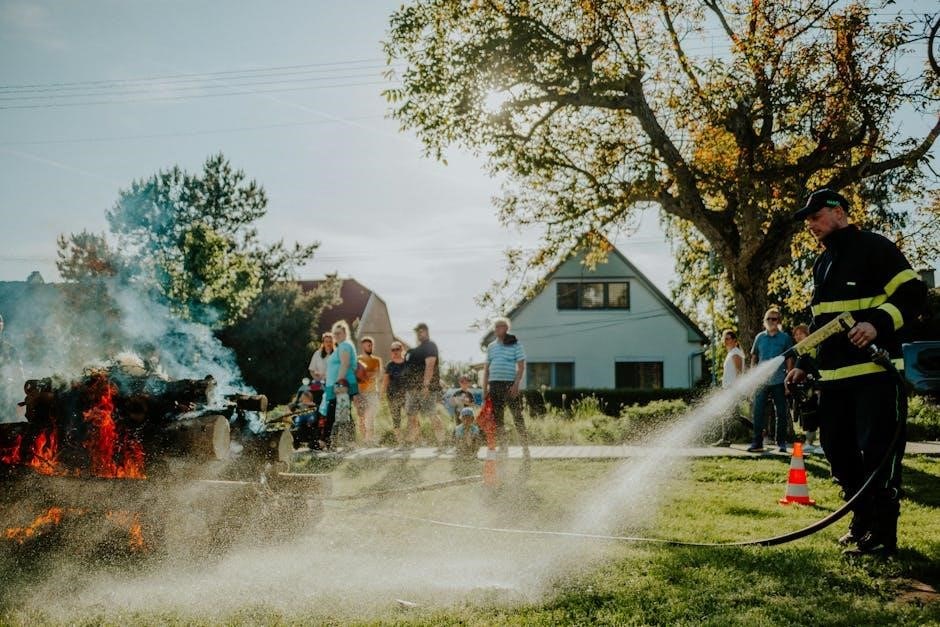
Uses of Fire Extinguishers
Fire extinguishers are essential for controlling fires in various environments, including homes, offices, and industrial settings. They are designed to address specific fire classes, such as Class A (combustible solids), Class B (flammable liquids), Class C (electrical equipment), and Class D (flammable metals). Proper use ensures safety and prevents fire escalation.
3.1 Class A Fires (Combustible Solids)
Class A fires involve combustible solids such as wood, paper, cloth, and textiles. These fires are common in both residential and commercial settings. Water-based fire extinguishers are most effective for Class A fires, as they cool the fuel and prevent re-ignition. Foam extinguishers can also be used, especially in environments with large quantities of combustible materials. Dry powder and wet chemical extinguishers are additional options, though water remains the primary choice due to its effectiveness and ease of use. Proper training in using the PASS method (Pull, Aim, Squeeze, Sweep) is essential for safely extinguishing Class A fires. Always ensure the extinguisher is rated for Class A fires to avoid exacerbating the situation.
3.2 Class B Fires (Flammable Liquids)
Class B fires involve flammable liquids such as gasoline, oil, paint, or propane. These fires require specialized extinguishing agents to prevent reignition. Foam, CO2, and dry powder extinguishers are effective for Class B fires, as they smother the flame and starve it of oxygen. Water-based extinguishers are unsuitable, as they can spread the fire or cause it to escalate. Proper training is essential to handle such scenarios safely. Always aim for the base of the fire and sweep the nozzle to ensure complete coverage. Remember, using the wrong extinguisher type can worsen the situation, so identification of the fire class is critical before taking action.
3.3 Class C Fires (Electrical Equipment)
Class C fires involve electrical equipment, such as computers, appliances, or wiring. These fires are particularly hazardous due to the risk of electric shock and reignition. CO2 fire extinguishers are highly effective for Class C fires, as they leave no residue and do not conduct electricity. Water mist extinguishers are also suitable for Class C fires, especially on equipment up to 1,000 Volts. It is crucial to disconnect power sources before extinguishing, if safe to do so. Proper use of these extinguishers ensures safety and prevents further damage. Always prioritize evacuation and professional intervention for large or unmanageable electrical fires. Regular inspection of electrical systems can help prevent such fires from occurring.
3.4 Class D Fires (Flammable Metals)
Class D fires involve combustible metals such as magnesium, titanium, and sodium, which require specialized extinguishing methods. Unlike other fire types, water and foam are ineffective and can worsen the situation. Dry powder fire extinguishers, specifically designed for Class D fires, are the most effective solution. These extinguishers smother the fire by creating a barrier between the metal and oxygen, preventing further combustion. Proper training is essential, as incorrect extinguishing techniques can lead to dangerous reactions. Always use equipment rated for Class D fires to ensure safety and effectiveness in controlling these unique and hazardous situations.
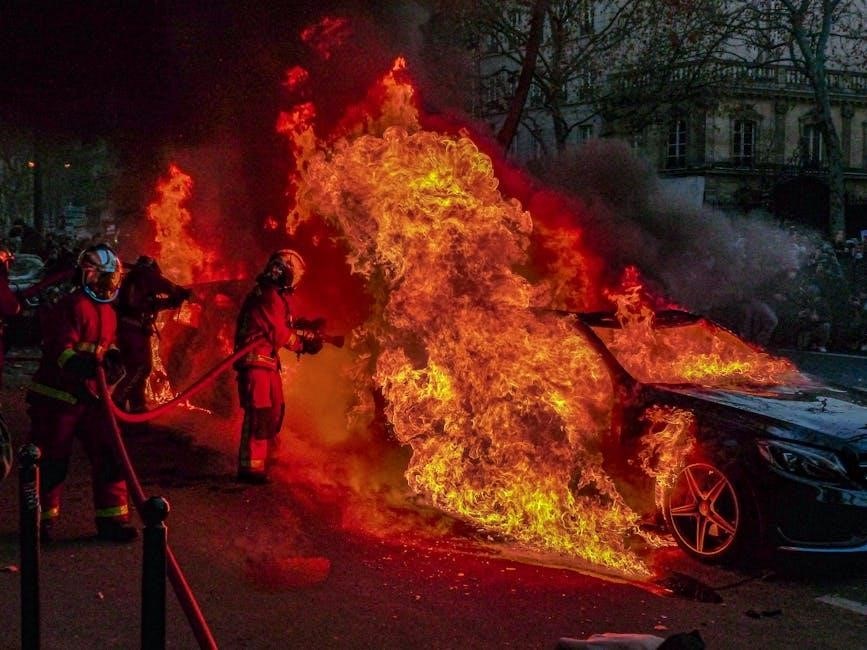
3.5 Class K Fires (Cooking Oils and Fats)
Class K fires involve cooking oils and fats, typically occurring in commercial kitchens. These fires are highly hazardous due to the intense heat and splashing that can occur when water is used. Wet chemical fire extinguishers are specifically designed to tackle Class K fires. They work by smothering the fire and cooling the surface, preventing re-ignition. It is crucial to use the PASS method: pull the safety pin, aim the nozzle at the base of the fire, squeeze the handle, and sweep the nozzle from side to side. Improper use of water or other extinguishers can worsen the situation, making wet chemical extinguishers the only safe choice for these types of fires.

Choosing the Right Fire Extinguisher
Selecting the appropriate fire extinguisher involves assessing fire hazards, matching extinguisher types to specific fire classes, and ensuring correct usage in emergency situations to maximize safety.
4.1 Assessing Fire Risks in Different Environments
Assessing fire risks involves identifying potential hazards in specific settings to determine the appropriate fire extinguisher types. In commercial kitchens, risks include cooking oils and fats, requiring wet chemical extinguishers. Industrial areas with flammable metals may need specialist dry powder units. Offices, prone to electrical fires, benefit from CO2 or water mist extinguishers. Understanding the fire class—such as Class A (combustible solids) or Class B (flammable liquids)—is crucial. Regular risk evaluations ensure preparedness for emergencies, adapting to changing conditions. This step is essential for selecting the right extinguishers and ensuring safety compliance. Proper assessment minimizes fire dangers and maximizes the effectiveness of fire safety measures in any environment.
4.2 Matching Extinguisher Type to Fire Class
Properly matching a fire extinguisher to the fire class is essential for effective fire control. Class A fires, involving combustible solids like wood and paper, are best tackled with water, foam, or dry powder extinguishers. Class B fires, which involve flammable liquids such as gasoline or oil, require foam, CO2, or dry powder extinguishers. Electrical fires (Class C) are safely managed with CO2 or dry powder types. Class D fires, involving flammable metals, demand specialized dry powder extinguishers. Class K fires, related to cooking oils, need wet chemical extinguishers. Always use the correct extinguisher type for the fire class to ensure safety and effectiveness. Incorrect use can worsen the situation.

4.3 Proper Use of Fire Extinguishers in Emergencies
Using a fire extinguisher effectively requires calmness and knowledge. Always assess the situation first; if the fire is too large or spreading quickly, evacuate and call professionals. Remember the PASS method: Pull the safety pin, Aim the nozzle at the base of the fire, Squeeze the handle to release the extinguishing agent, and Sweep the nozzle from side to side, covering the entire area. Never use the wrong type of extinguisher for the fire class, as this can worsen the situation. Ensure you have a clear escape route and avoid fighting fires that are too dangerous or beyond your control. Proper technique ensures safety and effectiveness.
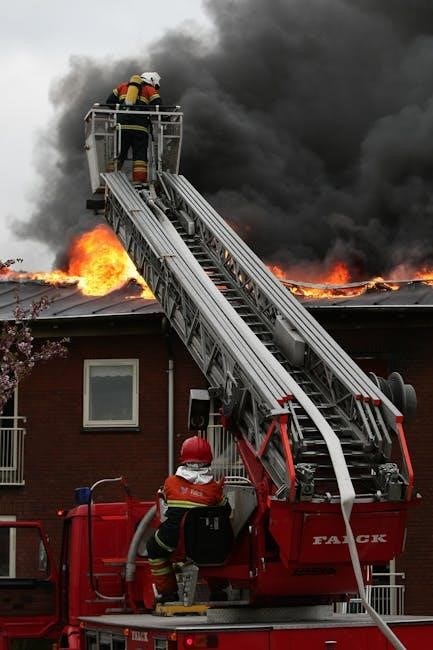
Maintenance and Safety Tips
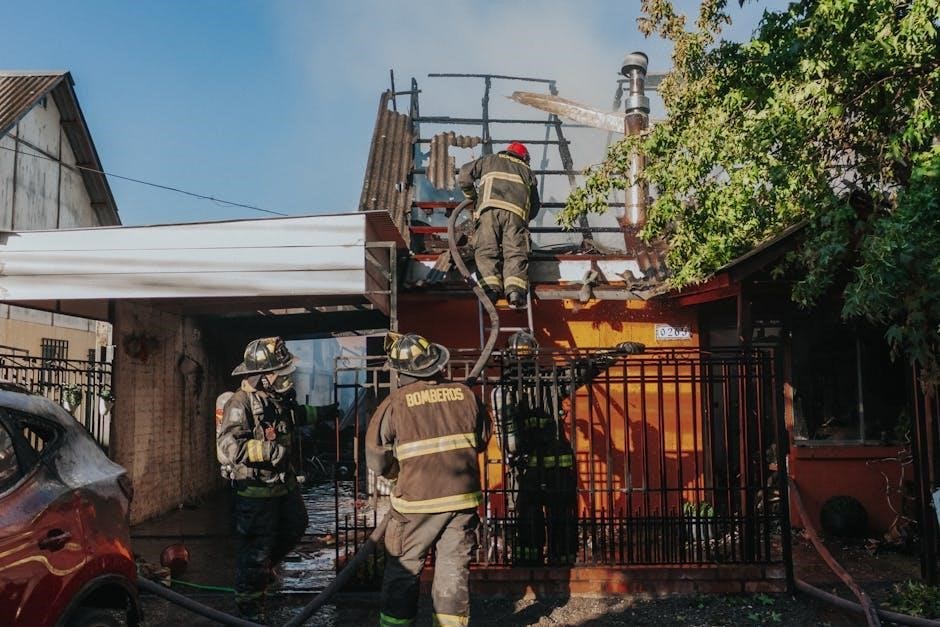
5.1 Regular Inspection of Fire Extinguishers
Fire extinguishers must be regularly inspected to ensure functionality. Check the pressure gauge, look for damage, and verify accessibility. Ensure the tamper seal is intact and no obstructions are present.
Regular inspection of fire extinguishers is crucial to ensure they are functional and ready for emergencies. Inspections should be conducted monthly and documented to comply with safety regulations. Check the pressure gauge to confirm it is within the recommended range. Examine the hose and nozzle for damage or blockages. Ensure the extinguisher is easily accessible and not obstructed. Verify that the tamper seal is intact to prevent unauthorized use. Look for any signs of corrosion, dents, or leaks on the cylinder. Labels and instructions should be clear and legible. If any issues are found, contact a professional for servicing or replacement. Proper maintenance ensures reliability and safety in critical situations.
5.2 Recharging and Refilling Fire Extinguishers
Recharging and refilling fire extinguishers are essential to ensure they remain functional and ready for emergencies. CO2 and wet chemical extinguishers typically require professional servicing to refill and recharge. Dry powder units must be recharged after use, as the powder can become compacted or contaminated. Water-based extinguishers are simpler, but their refill process still demands care to avoid contamination. Regular maintenance, including pressure checks and component inspections, is crucial to guarantee reliability. Always follow manufacturer guidelines and local fire safety standards when recharging or refilling extinguishers. Improper handling can lead to equipment failure, posing significant safety risks during a fire incident.
5.3 Storage and Accessibility Guidelines
Proper storage and accessibility of fire extinguishers are crucial for ensuring they are readily available during emergencies. Extinguishers should be mounted on walls or placed on stable stands, with the top of the unit no higher than 60 inches from the floor for easy access. They must be located along escape routes or in areas with high fire risks, such as kitchens or garages. Visibility is key; extinguishers should not be obstructed by furniture or equipment. Additionally, they should be protected from extreme temperatures, moisture, and physical damage. Regular checks should confirm that all units are fully charged and easily reachable. Accessibility ensures quick response in critical situations.
